Cole crops having family brassicaceae are one of the leading commercial vegetable groups in the world. Owing to its high nutritional value, brassicaceous plants and their hybrids, including various cultivars of cabbage, broccoli and mustard, are extensively grown across the world. It provides much needed dietary fibres, essential minerals and vitamins. Cole crops are also the major component of vegetables in north eastern states of India.
About 37 insect pests species have been reported to feed on cruciferous crops (Lal, 1975). Amongst all, diamondback moth, P. xylostella, webworm (Hellula undalis Fab.), cabbage butterflies (Pieris brassicae and Pieris rapae Linn.), aphids (Lipaphis erysimi (K.) and Brevicoryne brassicae Linn.) are most common insect pests on vegetable brassicas in India (Srinivasan and Murthy, 1991).
Therefore, keeping in view the importance of cruciferous crops in the country including north eastern region present communication is aims to determine the impact of different insect pest and theit management strategies.
1. Diamondback moth (DBM), Plutella xylostella (Plutellidae: Lepidoptera)
The larvae are pale yellowish green with fine black hairs scattered all over the body (Fig. 1). The moths are brown or gray, with conspicuous white spots on the fore wing, which appear like diamond pattern when the wings lie flat over the body (Fig. 2). The hind wings have a fringe of hairs.
Nature of damage: Damage is caused by the caterpillars which, in earlier stages, feed in mines on lower side of leaves and in the later stages, feed exposed on the leaves. The caterpillar bite hole by feeding on the leaves giving a shot-hole effect all over the body.
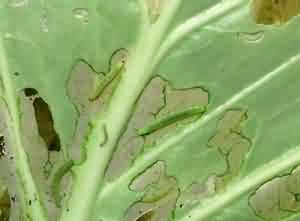
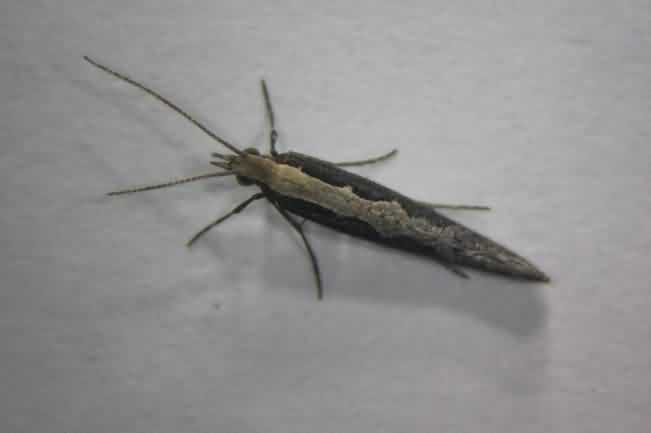
Fig. 1 Larval stage feed on leaf Fig. 2 Adult stage
2. Cabbage butterflies Pieris brassicae (Pieridae: Lepidoptera)
The butterfly is large yellowish white coloured butterfly with black fore wing tips and two prominent black spot on the forewings of females alone (Fig. 4). The young larvae are pale yellow, and become greenish-yellow later on.
The body of caterpillar is covered with short hairs and head is black and the dorsum is marked with black spots (Fig. 3). It causes extensive damage in almost all parts of India including north-eastern states during seedling, vegetative and flowering stages of cole crops (Sachan and Gangwar, 1980)
Nature of damage: The caterpillar alone causes damage. The first instar larvae just scarp the leaf surface, whereas the subsequent instars eat up leaves from the margine inwords,leaving intact the main veins. Often, entire plants are eaten up.
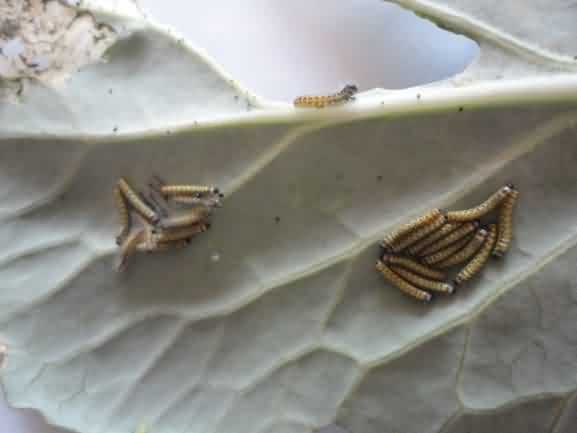
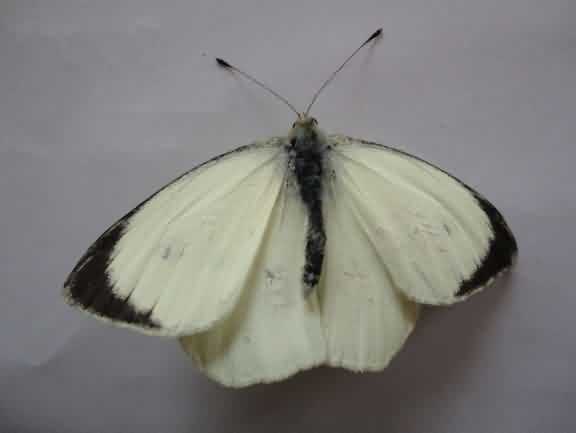
Fig.3 Larval stage feed on leaf Fig. 4 Adult stage
3. Cabbage stem borer, Hellila undalis (Pyralidae: Lepidoptera)
The adult moth is slender, pale yellowish-brown having gray wavy lines on the fore wings (Fig. 6). The caterpillar is creamy yellow with a pinkish tinge and has seven purplish brown longitudinal stripes (Fig. 5).
Nature of Damage: The caterpillar first mine into the leaves. Later on, they feed on the leaf surface, sheltered within the silken passage. As they grow bigger they bore into the heads of cauliflower and cabbage. When the attack is heavy, the plants are riddled with worms and outwardly the heads look defofmed.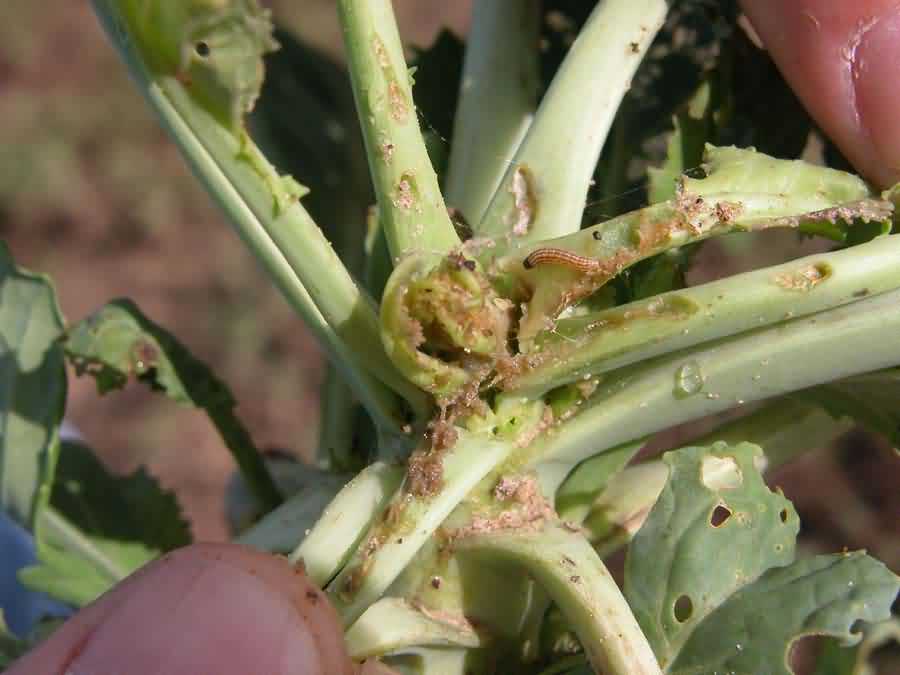
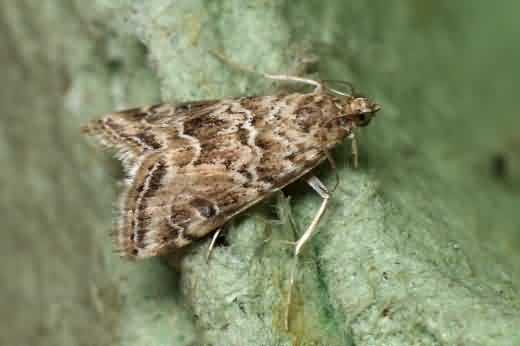
Fig. 5 Larvae feed on cabbage Fig.6 adult moth
4. Mustard sawfly, Athalia lugens proxima ( Tenthrinidae: Hymenoptera)
The larvae are greyish colour with five yellow orange lateral stripes on the body (Fig. 7). It has the tendency to curl up and drop on the ground on being touched.
Nature of Damage: The larvae feed on the leaves by making holes. Sometimes they eat up entire laminate of leaf leaving behind the midrib.
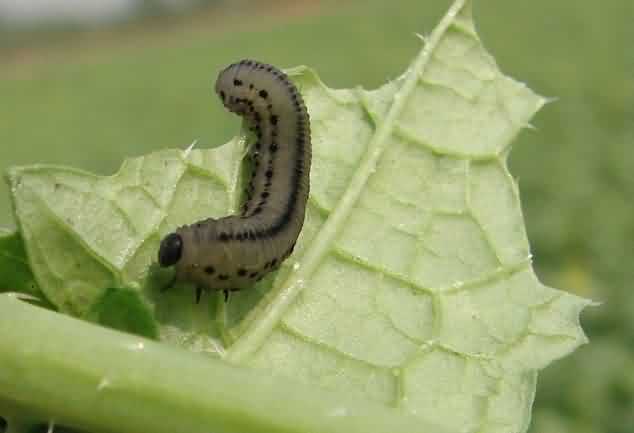
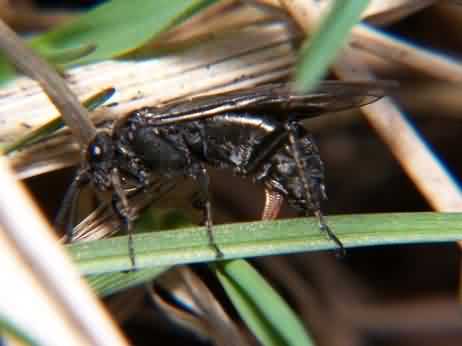
Fig. 7 mustard sawfly larva Fig. 8 Adult sawfly
5. Cabbage aphid, Brevicoryne brassicae (Aphididae: Hemiptera)
The aphids are small, yellowish green and soft and oval body insects and usually 2.5-3 mm in length. This is a very sluggish insect and does not move much in its wingless form (Fig. 9).
Nature of Damage: Both nymph and adult suck the sap of the tender part of the plants. They enter the inner leaves of the head and in cauliflower all the inner space in the head is filled by the aphi, thus making the vegetable unmarketable.

Fig. 9 Adult cabbage aphids
Management Strategies:
Cultural Control:
- Remove and destroy all the remnant, stuble, debris after the harvest of crops and plough the field
- Intercropping of cabbage with tomato, Lucern or marigold reduce the incidence of Diamondback moth.
- Grow mustard as trap crop, Raise 2 rows of mustard for every 25 rows of cabbage. Sow first mustard crop15 days prior to cabbage planting or plant 20 days old mustard seedling at the time of cabbage planting.
- Plant 35 days old cabbage seedlings.
Mechanical Control:
- Set up yellow sticky trap @ 4/acre for cabbage aphids.
- Install pheromone trap having synthetic sex pheromone of P. xylostella [(Z)- 11- hexadeccnal, (Z)-11- hexadecenyl acetate, (Z)-11- hexadecen-1-ol, and antioxidant, in the ratio of 50:50:1:5 micro g/septum] to monitor and control DBM adults @ 5 traps/ac.
Biological Control:
- The pest is regulated by two larval parasitoids viz., Cotesia plutellae and Diadegma semiclausum in hills. Release 40,000 adults/ac @ 8,000 adults/release commencing from 20 days after planting to reduce DBM damage
- Apply Becillus thuringiensis 400 g or NSKE 4% spray.
Chemical Control:
- Depending upon the pest intensity, spray cartap hydrochloride 0.05% or carbosulfan 0.025% or quinalphos 0.05% or Dimethoate 400 ml/acre at primordial or head initiation stage.
- Soil application of corbofuran @ 1 kg a.i./ha at a distabce between 4-8 cm around the stem at the bolting stage for the management of cabbage butterfly.
References
- Lal, O.P. (1975). A compendium of insect pest of vegetables in India. Bull. of Entomol., 16: 31-56.
- Sachan, J.N., Gangwar, S.K. (1980). Vertical distribution of important pests of cole crops in Meghalaya as influenced by the environmental factors. Indian J Entomol. 42:414–421.
- Srinivasan, K. and Murthy, P.N.K. (1991). Mustard plants trap major cabbage pests. Indian Farm., 40: 11-12.
Authors:
Pritin Sontakke1, J. Panging1 , S. Choudhury2 and A. Debnath2
1Senior Research Fellow, Division of Crop Improvement (Entomology), ICAR-Research Complex for NEH Region, Umiam, Meghalaya-793 103.
2 Research Associate, Division of NRM, ICAR-Research Complex for NEH Region, Umiam, Meghalaya-793 103.
Email:
